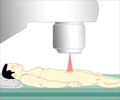Foregoing aggressive treatment of low-risk prostate cancer in older patients, especially those with other health issues, could prevent harm due to treatment-related side effects, while also providing a savings to Medicare.

‘Medicare cost for treating prostate cancer in older men aged 70 and above is estimated to be more than $12 billion. ’





"The tough discussions that happen in health economics are often cases where care is beneficial, but costly. That's a hard trade-off, but this one is actually easier than that," said UNC Lineberger's Justin Trogdon, PhD, associate professor of health policy management in the UNC Gillings School of Global Public Health, and the study's first author. "This is a scenario where care is probably not beneficial and also costly, and we are putting a dollar figure on just how costly this is." The researchers said there is a wide recognition that screening for prostate cancer should stop in men at age 70. The U.S. Preventive Services Task Force recommends against prostate cancer screening in men above age 70, citing, among other reasons, that the harms from screening are "at least moderate" or greater for men in that age group because of risk of false-positives, harms from biopsy, and harms from treatment, which can include sexual dysfunction and urinary incontinence.
"For patients who are diagnosed with prostate cancer at an older age, because the cancer is often slow-growing, it is unlikely to be the cause of their mortality," said UNC Lineberger's Ronald C. Chen, MD, MPH, associate professor in the UNC School of Medicine Department of Radiation Oncology and the study's corresponding author. "So, we are not only spending U.S. health care dollars diagnosing an issue that probably isn't going to be a problem for patients, but when we treat these patients who don't need treatment, they suffer unnecessary side effects like urinary incontinence or sexual dysfunction."
For the retrospective study, researchers used the National Cancer Institute Surveillance, Epidemiology, and End Results (SEER)-Medicare linked claims database to analyze costs related to diagnosis and work-up, treatment, follow-up, and side-effect management for nearly 50,000 men 70 years of age or older who were diagnosed with prostate cancer between 2004 and 2007. They estimated the cost of diagnosing and treating men for three years after diagnosis because that's a typical time frame for patients to receive treatment in.
They found that for men diagnosed in each year, the total three-year cost was $1.2 billion. For men diagnosed in 2004, for example, their estimated cost to Medicare would be $1.2 billion across three years. The median per-patient cost within three years after prostate cancer diagnosis was $14,453, with treatment costs accounting for 73 percent of that total. The researchers estimated a cost savings of $320 million per year for Medicare if patients who have a Gleason score of 6 choose active surveillance.
Advertisement
They suggest that screening men with at least a 10-year life expectancy, and selectively treating those with more aggressive cancer may be one approach to eliminate unnecessary spending while maximizing patient outcomes.
Advertisement















